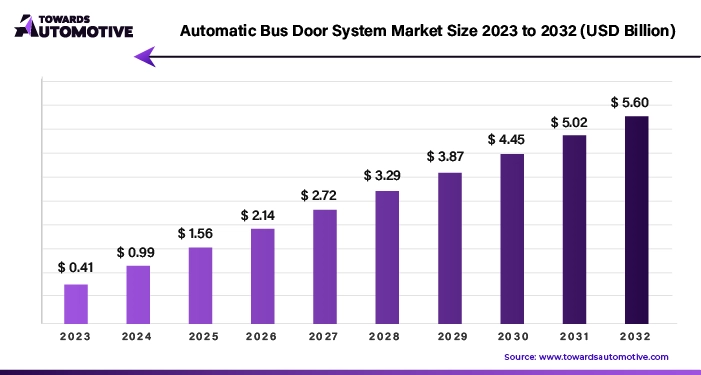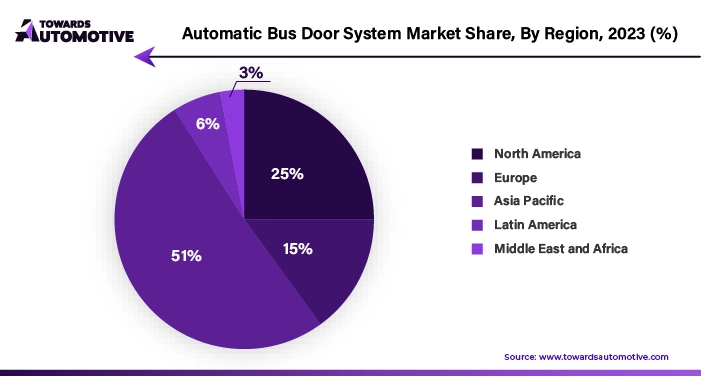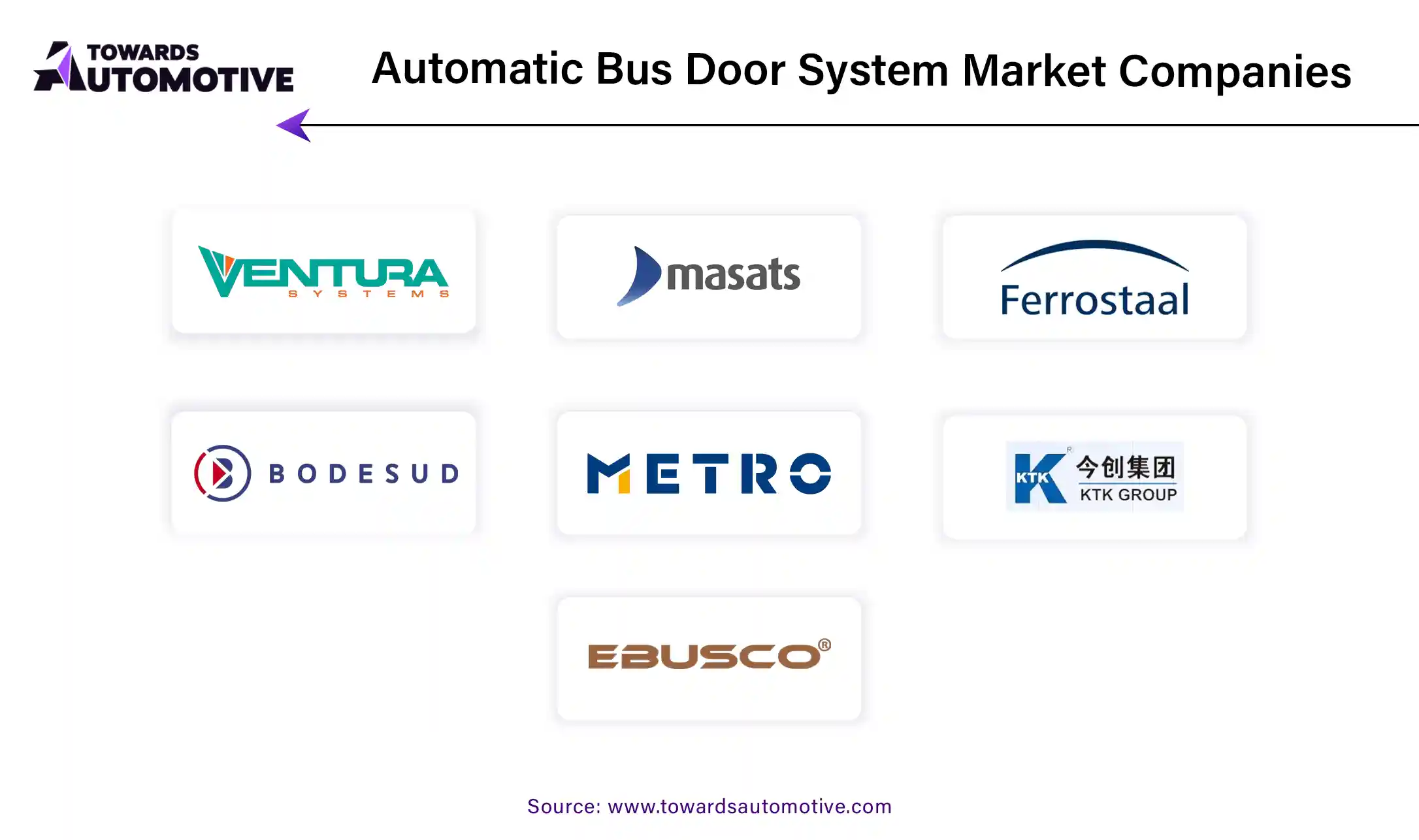April 2025
The automatic bus door system market is set to grow from USD 0.60 billion in 2025 to USD 3.42 billion by 2034, with an expected CAGR of 21.28% over the forecast period from 2025 to 2034.

Unlock Infinite Advantages: Subscribe to Annual Membership
The automatic bus door system market is witnessing significant growth and is projected to expand to a substantial valuation by 2032, driven by various factors such as urbanization, increasing demand for public transportation, and technological advancements in the transportation sector. Automatic bus door systems play a critical role in enhancing passenger safety, comfort, and operational efficiency in public transit vehicles, thereby fueling the demand for these systems across the globe.
One of the primary drivers of market growth is the rapid urbanization and population growth in urban areas worldwide. As cities continue to expand, the demand for efficient and reliable public transportation systems rises. Automatic bus door systems contribute to the smooth operation of public transit vehicles by facilitating quick and safe boarding and disembarking of passengers, thereby improving the overall efficiency of urban transit systems.
Additionally, the increasing emphasis on passenger safety and comfort is driving the adoption of automatic bus door systems. These systems feature advanced safety mechanisms such as obstacle detection sensors, anti-pinch technology, and emergency release mechanisms, which enhance passenger safety and prevent accidents during boarding and disembarking. Moreover, automatic bus door systems help minimize air and noise pollution by reducing the time spent at bus stops, leading to a more comfortable and pleasant commuting experience for passengers.
Furthermore, technological advancements in the transportation sector, including the development of electric and autonomous buses, are propelling the demand for automatic bus door systems. Electric buses are gaining popularity due to their environmental benefits and lower operating costs compared to traditional diesel buses. As electric buses become more widespread, the need for efficient and reliable door systems compatible with electric vehicle platforms increases, driving market growth.
Despite the positive growth outlook, the automatic bus door system market faces challenges and constraints that may hinder its expansion. One of the primary challenges is the high initial cost of deploying automatic bus door systems. While these systems offer numerous benefits in terms of safety, efficiency, and passenger comfort, the upfront investment required to install them in existing bus fleets can be substantial. This cost factor may deter some transit agencies and bus operators from adopting automatic door systems, especially those operating on tight budgets or facing funding constraints.
Moreover, the retrofitting of automatic bus door systems into older bus models can pose technical challenges and compatibility issues. Retrofitting may require modifications to the bus structure, electrical systems, and onboard controls, which can be complex and time-consuming. Transit agencies and bus operators must carefully assess the feasibility and cost-effectiveness of retrofitting automatic door systems into their existing fleets, considering factors such as vehicle age, condition, and expected service life.
Additionally, regulatory compliance and safety standards pose challenges for manufacturers and suppliers of automatic bus door systems. Transit agencies and bus operators must ensure that automatic door systems meet all relevant safety regulations and standards, including those related to passenger safety, accessibility, and emergency egress. Compliance with these standards may involve rigorous testing, certification, and documentation processes, adding complexity and costs to the development and deployment of automatic door systems.
Despite these challenges, market players are actively investing in research and development initiatives to overcome technical barriers and enhance the functionality and reliability of automatic bus door systems. Collaborative efforts with transit agencies, bus manufacturers, and regulatory authorities are also underway to address safety concerns and ensure compliance with industry standards.
In 2022, the Asia Pacific region emerged as a dominant force in the automatic bus door system market, commanding an impressive 60% of the revenue share. This significant market share reflects the region's increasing emphasis on enhancing public services, particularly in the realm of public transportation, where there's a growing demand for advanced door systems that prioritize passenger safety and convenience.

One of the primary drivers of the market's growth in the Asia Pacific region is the concerted effort to improve the overall quality of public transportation services. As urban populations continue to swell across the region, the need for efficient and reliable transit options becomes ever more pressing. In response to this demand, transit authorities and operators are increasingly turning to automatic bus door systems to streamline boarding and alighting processes, thereby enhancing the overall passenger experience.
Furthermore, stricter regulations governing accessibility and passenger security are serving as catalysts for the widespread adoption of automatic bus door systems. Governments across the Asia Pacific region are enacting legislation aimed at ensuring that public transportation services are accessible to all individuals, including those with disabilities. Automatic door systems play a crucial role in meeting these regulatory requirements by facilitating barrier-free access for passengers of all abilities.
Moreover, the Asia Pacific region is witnessing a surge in investments in electric buses and the retrofitting of existing fleets with eco-friendly technologies. As governments and transit agencies prioritize sustainability initiatives to combat air pollution and reduce greenhouse gas emissions, there arises a need for automatic door systems that can seamlessly integrate with electric bus platforms. This presents a significant opportunity for market expansion as the region transitions towards greener and more sustainable urban transit solutions.
With a growing commitment to sustainable urban transit, the automatic bus door system market in the Asia Pacific region is poised for continued expansion to meet these evolving needs. As transit operators seek to modernize their fleets and improve the quality of service offerings, the demand for advanced door systems that enhance safety, accessibility, and passenger comfort will only continue to rise. Consequently, the Asia Pacific region is expected to remain a key growth engine for the automatic bus door system market in the foreseeable future.
By Door Type
By Application
By Technology
By Bus Type
By Geography

These companies are at the forefront of innovation in the automatic bus door system market, offering a wide range of products and solutions tailored to the needs of transit agencies, bus manufacturers, and passengers.
These recent developments underscore the dynamic nature of the automatic bus door system market, with companies introducing innovative products and solutions to meet the evolving needs of the transportation industry.
The COVID-19 pandemic had a significant impact on the automatic bus door system market, disrupting supply chains, reducing demand for public transportation services, and delaying investments in new bus fleets and equipment. As governments implemented lockdown measures and restricted movement to curb the spread of the virus, public transit agencies experienced a sharp decline in ridership, leading to revenue losses and budget constraints.
Moreover, the pandemic-induced economic downturn affected the purchasing decisions of transit agencies and bus operators, leading to postponements of fleet renewal and equipment upgrades, including automatic bus door systems. With limited financial resources and uncertain revenue projections, transit agencies prioritized essential expenditures and deferred non-essential investments in new vehicles and equipment.
Furthermore, the pandemic highlighted the importance of hygiene and cleanliness in public transportation, leading to increased demand for contactless solutions, including automatic bus door systems. Transit agencies and bus operators implemented various measures to enhance passenger safety and reduce the risk of virus transmission, including the installation of automatic door systems with touchless operation and improved ventilation systems.
Overall, while the COVID-19 pandemic presented significant challenges to the automatic bus door system market, it also highlighted the importance of automation, safety, and hygiene in public transportation. As the global economy recovers and public transit ridership rebounds, the market is expected to recover gradually, with renewed investments in fleet modernization and equipment upgrades driving demand for automatic bus door systems.
Despite the challenges posed by the COVID-19 pandemic, the automatic bus door system market is poised for significant growth in the coming years, driven by urbanization, increasing demand for public transportation, and technological advancements in the transportation sector. Transit agencies and bus operators are increasingly recognizing the benefits of automatic door systems in enhancing passenger safety, comfort, and operational efficiency, leading to greater adoption of these systems worldwide.
Moreover, the transition towards electric and autonomous buses is expected to create new opportunities for market players, with a growing demand for automatic door systems compatible with electric vehicle platforms and driverless transportation solutions. Continued investments in research and development, along with collaborative efforts between industry stakeholders, will further drive innovation and product development in the automatic bus door system market, meeting the evolving needs of the transportation industry and improving the overall passenger experience.
April 2025
April 2025
April 2025
April 2025
Dr. Arjun Patel is a distinguished expert in the automotive industry, holding advanced degrees in Automotive Engineering and Mechanical Engineering. His expertise spans automotive market dynamics, technological advancements, and sustainable practices. Dr. Patel excels in conducting in depth research and analysis on market trends, consumer preferences, and the economic implications within the automotive sector. He is renowned for his insightful publications on topics such as electric vehicles, autonomous driving technologies, and the evolution of sustainable transportation solutions. Dr. Patels research contributions have significantly advanced understanding in the field, earning him recognition as a leading authority in automotive research and analysis.
We offer automotive expertise for market projections and customizable research, adaptable to diverse strategic approaches.
Contact Us